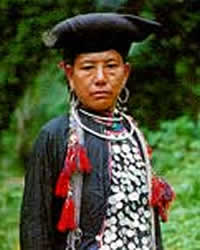Sila in Laos

Photo Source:
Anonymous
|
Send Joshua Project a map of this people group.
|
| People Name: | Sila |
| Country: | Laos |
| 10/40 Window: | Yes |
| Population: | 3,500 |
| World Population: | 4,400 |
| Primary Language: | Sila |
| Primary Religion: | Ethnic Religions |
| Christian Adherents: | 0.12 % |
| Evangelicals: | 0.12 % |
| Scripture: | Translation Started |
| Ministry Resources: | No |
| Jesus Film: | No |
| Audio Recordings: | No |
| People Cluster: | Tibeto-Burman, other |
| Affinity Bloc: | Tibetan-Himalayan Peoples |
| Progress Level: |
|
Introduction / History
Like other Tibeto-Burman peoples, the Sila migrated from southern China. They are part of the Lolo linguistic groups, who were the dominant power in Southern China in the eighth and ninth centuries. In the early ninth century, they made their way into Southeast Asia.
Today they inhabit the hilly, tropical forests just north of Muong Hai in north central Laos. They are a Tibeto-Burman people with Mongoloid features and are an official nationality in Vietnam. Lacking specific information on the Sila, some assumptions have been made, based on their location in Laos as well as neighboring ethnic groups with similar backgrounds.
What Are Their Lives Like?
Hill peoples such as the Sila farm and raid the forests for wild game and valuable things to sell and eat. They struggle with malnutrition and diseases such as malaria. Sila villages consist of small groups of houses made of wood or bamboo, built on stilts and clustered against the sides of the hills. Their residential areas are usually adjacent to their farmlands. With the houses built above the ground, the family livestock-poultry, pigs and goats-run freely underneath the houses. Because their villages are usually organized around tribal lineage, it is likely that their social structure is based on family units. Their residential areas are usually adjacent to their farm lands.
The northern provinces of Laos have an ideal climate for growing opium-producing poppies. The tribal people are known to have traditionally used opium as a medicine, a cash or barter crop and a drug. Drugs produced in this area generally move north on routes into China. Even if the Sila are not involved in the opium trade, it adversely affects their lives.
What Are Their Beliefs?
The Sila practice an ethnic religion, which is often a blend of animism and ancestor worship. Animism includes the belief that forces and aspects of nature (wind, rivers, trees, earth) are attached to spirits or supernatural beings. These spirits help find or grow food, cure illness, and avert danger. Through sacrifice and ritual, the worshipper tries to manipulate the spirits into helping him.
Ancestor worship involves praying to the spirits of deceased ancestors for protection, guidance, or blessings. They believe that ancestral spirits are alive and must be fed and cared for.
What Are Their Needs?
Malaria, influenza, dysentery and pneumonia are major health problems, and malnutrition is widespread. Infant mortality rates are high, and life expectancy is low. Village infirmaries and dispensaries were built, and medical workers were trained in most of the provinces. These village medical workers, often using only traditional medicinal herbs, now provide most of the primary health care, but it is not adequate for the great need.
Prayer Points
Pray for loving workers to go to the Sila people, and for their hearts to be ready to receive their savior.
Pray for many from the Sila people to understand both God's judgment and his majestic glory and goodness.
Pray for a chain reaction of families reaching families that result in thousands of new disciples who share their faith with others.
Pray for grace and truth expanding into their entire society as all believers learn to love others.